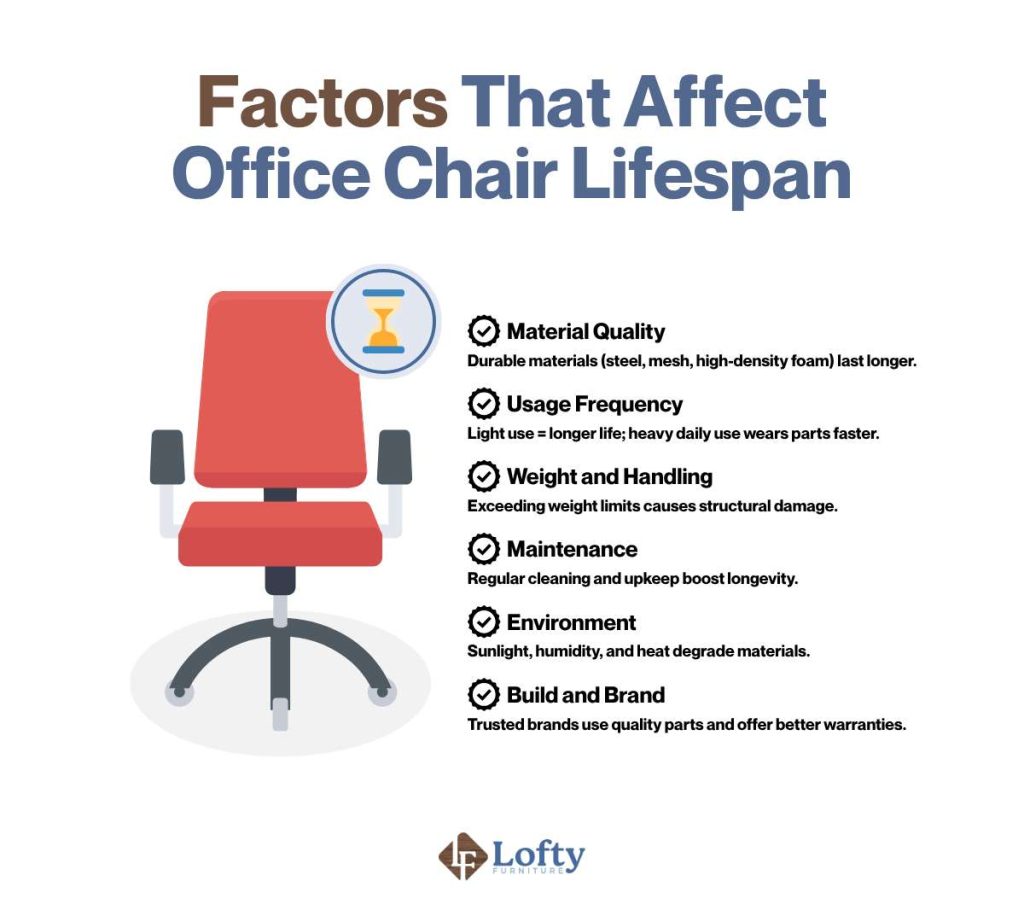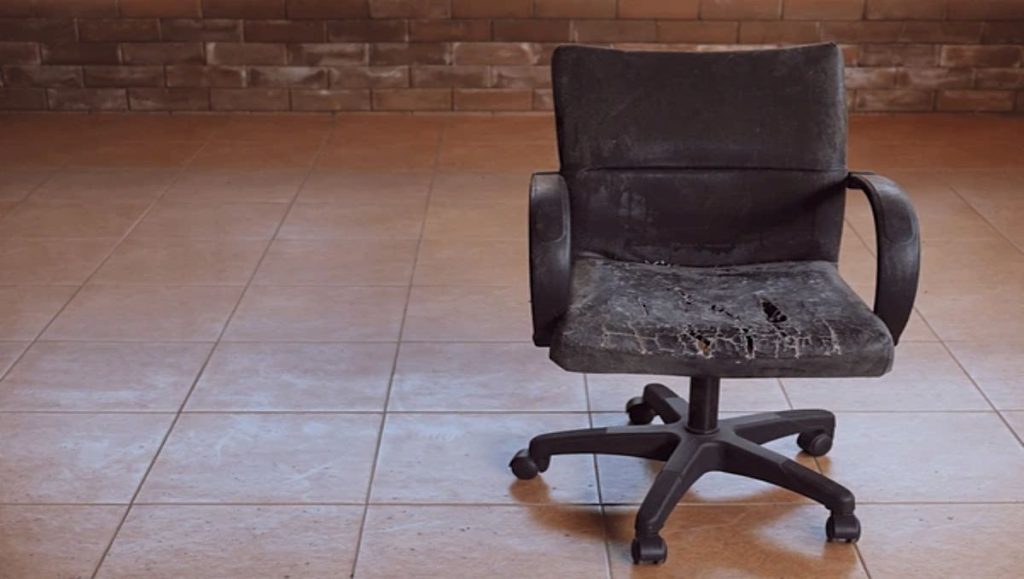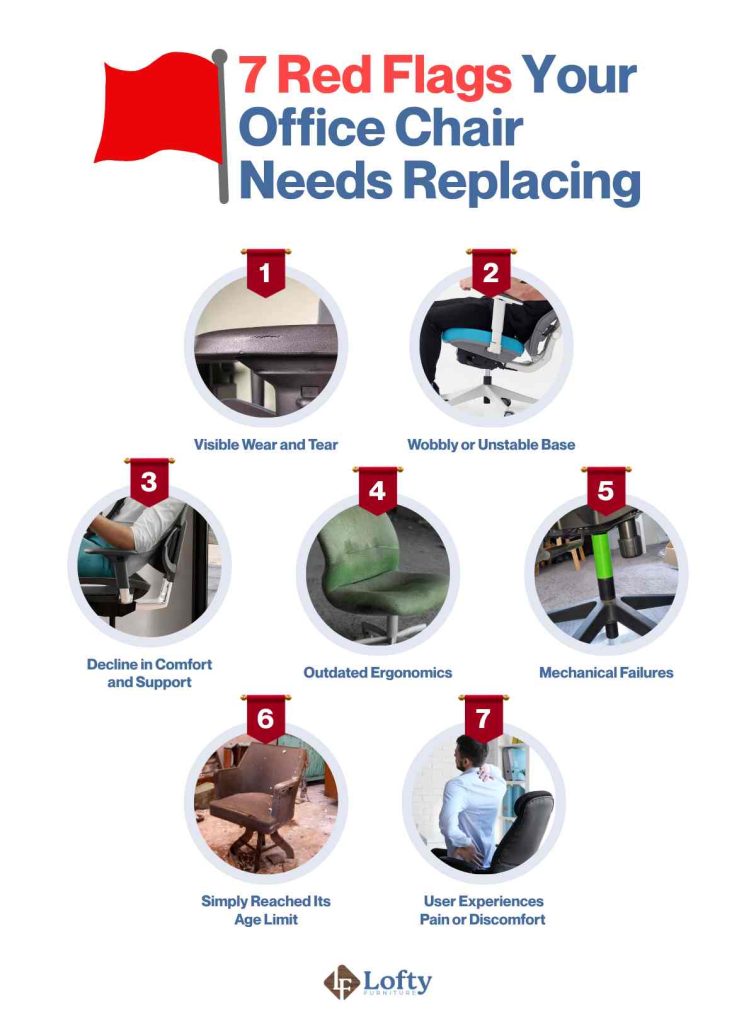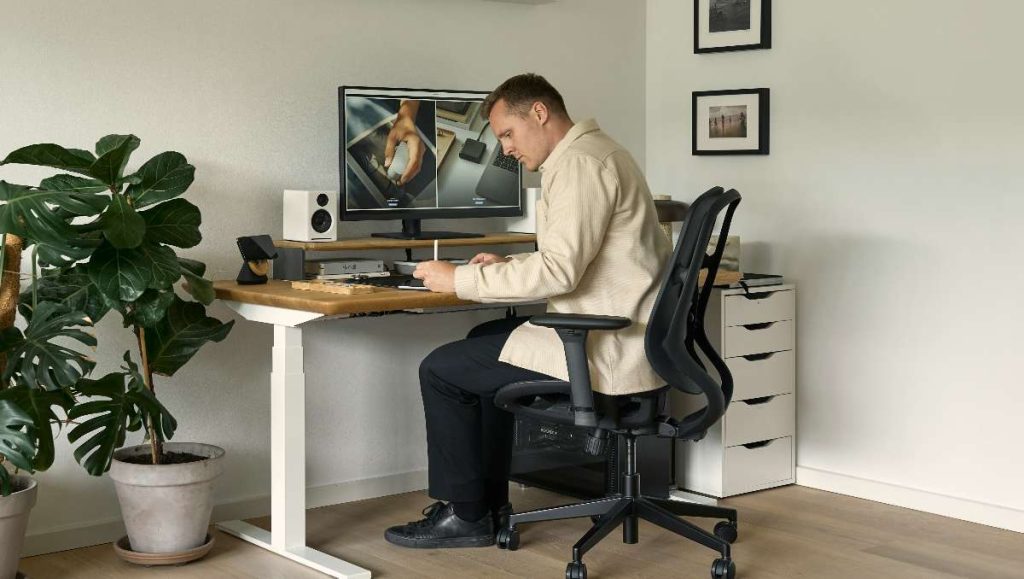If you’ve ever found yourself shifting uncomfortably in your office chair by mid-afternoon, wondering when it stopped being supportive and started being a pain—literally—you’re not alone. Office chairs are one of those things we tend to take for granted, quietly doing their job day in and day out. But just like any well-used tool, they don’t last forever. Whether you’re working from home or clocking in at the office, your chair plays a huge role in how you feel throughout the day. So how do you know when it’s time to say goodbye and invest in a new one?
Key Takeaways:
- Office chairs typically last 5-10 years, depending on quality, usage, and maintenance.
- Replace your chair when you see visible damage, structural issues, or experience discomfort/pain, as these signal a breakdown in support and safety.
- Maximize your chair’s life with regular cleaning, tightening loose parts, and proper use within its weight limit.
In this article, we’ll break down how long office chairs typically last, what factors affect their lifespan, and the telltale signs it might be time for an upgrade. Your back will thank you.
How Long Do Office Chairs Last? The Expected Lifespan
Most office chairs last around 7 years, but this can vary quite a bit depending on several key factors. The quality of the materials, how heavily the chair is used, and how well it’s cared for all play a role in how long it holds up.
One major factor? The type of chair and what it’s made of. Here’s a quick breakdown of how long different styles and materials typically last:

Beyond materials, how you use your chair also matters. A chair used for a couple of hours a day will naturally last longer than one supporting someone through 10-hour workdays. Likewise, chairs consistently used by individuals close to or over the weight limit will experience more wear and tear over time.
What Affects How Long an Office Chair Lasts?
When it comes to how long an office chair lasts, several key factors come into play. First, material quality matters—a chair made with steel frames, mesh backrests, and high-density foam will generally outlast one made with cheaper components. How often you use the chair also makes a big difference; occasional use puts less strain on the cushions and mechanics, while daily use for long hours (6–10 hours a day) wears things down faster. Weight capacity and how the chair is handled are important too—using it beyond its recommended limit can cause structural stress over time.
Maintenance plays a role as well; simple habits like cleaning, tightening bolts, and lubricating moving parts can go a long way in extending the chair’s life. You should not overlook the environment either—constant exposure to sunlight, humidity, or extreme temperatures can damage fabrics and plastics. Lastly, the chair’s build quality and brand reputation matter—chairs from trusted brands tend to be made with more durable components and often come with better warranties.

Critical Signs It’s Time to Replace Your Office Chair
So, when should you get a new office chair?
While office chairs typically last between 5 to 10 years, your body and the chair itself will often give you clues it’s time to upgrade, especially if you’re experiencing new aches or reduced functionality. You should consider getting a new office chair when it starts showing the following signs:
You Notice Visible Wear and Tear
If you observe a significantly sagging seat cushion or flattened padding, it’s a clear sign that the foam has lost its density and ability to provide crucial support. Similarly, torn or frayed upholstery isn’t just an aesthetic problem; it compromises the chair’s integrity and can harbor dirt and allergens, affecting both comfort and hygiene.

Structural and Mechanical Issues Arise
A chair that feels wobbly, unstable, and leans noticeably in any direction indicates a severe compromise in its underlying frame or connection points, posing a direct safety risk. Even more frustrating, and potentially dangerous, are difficulties with adjustments or outright malfunctioning mechanisms. If your chair constantly sinks, the internal components have likely worn out or broken.
Annoyed by squeaky noises? Learn how to fix a squeaky office chair in just 5 easy steps and bring back quiet comfort to your workspace.
Ergonomics and Comfort Are Compromised
Persistent discomfort or pain, especially in your lower back, neck, or shoulders, is a glaring sign that your chair is no longer providing adequate ergonomic support. As health professionals emphasize, the wrong chair can compromise your body’s natural alignment, leading to significant health consequences.
It’s Simply Reached Its Age Limit
Even if your office chair doesn’t exhibit dramatic signs of wear and tear or obvious mechanical failures, its age alone can be a compelling reason for replacement, especially under consistent heavy use. Most office chairs, even high-quality ones, have an expected lifespan, and surpassing this typically means that the materials, foam density, and internal mechanisms have undergone significant unseen degradation.
Persistent Pain or Discomfort
If you regularly feel back, neck, or shoulder pain after sitting, it’s a strong sign your chair isn’t supporting you properly. Poor seating can lead to muscle strain and even long-term injuries, which not only affect your health but also your productivity.

Ready to upgrade? Discover ergonomic office chairs designed for lasting support and durability now!
Investing in a New Office Chair: What to Look For
So, how often should you replace an office chair? The truth is, it depends. There’s no fixed rule, but if your chair is more than five years old, feels uncomfortable, or shows signs of wear like sagging cushions or noisy adjustments, it’s probably time for a new one. I didn’t realize how much my old chair was affecting me until I switched—I went from constant backaches to sitting comfortably all day just by upgrading.
When you’re shopping for a replacement, don’t just focus on looks. The most important feature is adjustability. Look for a chair with seat height adjustment so your feet can rest flat on the floor with your knees at a 90-degree angle. Seat depth adjustment is key for proper thigh support, and the backrest should offer height options for lumbar support and let you shift positions during the day. Material matters too—breathable fabric helps with comfort, especially during long hours—and a strong warranty usually signals solid build quality. Choosing the right chair really can change the way you feel at work.

Not sure if your office setup adds value to your startup? Learn how furniture fits into your assets.
How to Maximize Your Office Chair’s Lifespan
With a few simple, consistent maintenance practices, you can significantly prolong your chair’s functionality and appearance.
- Regular Cleaning is Key: Make it a habit to regularly dust and wipe down all surfaces of your chair, including the base, arms, and back, using a soft, damp cloth.
- Tighten Loose Screws and Bolts: This prevents wobbling, noisy operation, and premature wear on connection points.
- Lubricate Moving Parts: If your chair starts to squeak, creak, or feel stiff when adjusting, apply a silicone-based lubricant to the casters, gas lift, and other mechanisms.
- Adhere to Weight Limits: Always be mindful of your chair’s specified weight capacity.
- Protect from Environmental Factors: Position your chair away from direct sunlight, which can cause upholstery to fade, crack, or degrade over time.
- Mind Your Flooring: For carpeted areas, hard-wheel casters or a mat can help the chair roll more smoothly and prevent debris from accumulating in the wheels.
The Bottom Line (Literally): When It’s Time for a New Chair
An office chair might seem like a simple fixture in your workspace, but its impact on your comfort, posture, and long-term health is anything but minor. Knowing how long do office chairs last and recognizing the red flags that indicate it’s time to replace them can save you from chronic discomfort and even costly medical bills down the line. Regular inspection, proper care, and making informed upgrade decisions when needed will ensure your seat continues to support—not sabotage—your productivity and well-being.
FAQs
What is the average lifespan of office furniture?
The average lifespan of office furniture varies by item, but for chairs specifically, it’s generally between 5 to 10 years. Desks, filing cabinets, and storage units often last longer—10 to 15 years or more—depending on quality, usage, and maintenance.
How can I tell if my office chair’s gas lift mechanism is failing?
Common signs include the chair sinking slowly over time, failing to stay at the desired height, or feeling bouncy or unstable when adjusting. A faulty gas cylinder usually means the internal seal has worn out and the pressure is no longer holding.
Is it more cost-effective to repair or replace an aging office chair?
If the chair is high-end and the damage is minor (e.g., just the gas lift or casters), repair may be worth it. However, if multiple parts are worn out or if the chair is over 7–8 years old, replacement is usually more cost-effective and ergonomically beneficial.
Do office chairs expire?
Office chairs don’t have a strict expiration date like food. But they do wear out and lose functionality over time because of regular use and environmental factors.
